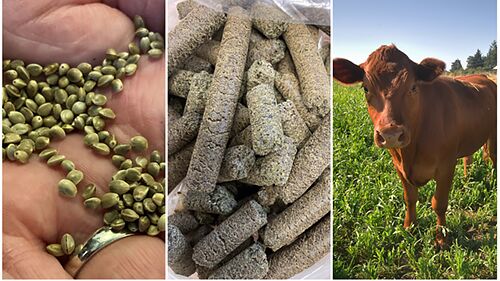There is an easy answer, and there is a right answer. A general guideline is that lactating cows need two gallons of water per 100 pounds of bodyweight per day. Bulls and dry cows need one to one and a half gallons of water per 100 pounds per day, according to the 2016 Nutrient Requirements of Beef Cattle.
Water needs are influenced by environmental temperature, class of livestock, weight, and stage of production. The warmer it gets, the more water cows need. Cows with nursing calves need more water than dry cows. As cattle gain weight, they need more water.
As an example, spring calving cows will need close to 20 to 24 gallons of water per day for themselves and another 5 to 10 gallons for their calf when it gets hot.
Some water comes from the feed they eat, and grass can be high in water content. Nursing calves meet some of their daily water needs with their dam’s milk. However, it’s best to plan on making sure cattle have access to the full recommended amount of good-quality water. It’s particularly important that calves are able to reach the water levels in a tank, especially in hot weather. If cows come into water first and drink a tank down, calves may struggle to get a drink if there is a slow recharge on the water tank. This can lead to stress and health problems for calves. Depending on the watering system, giving calves “creep” access to a water tank they can reach separate from the cows can help to ensure calves stay hydrated.
The importance of water to beef cattle is often overlooked, and cattle performance can be affected by water intake. Nutritionists balance diets for carbohydrate (energy), protein, vitamins, and minerals but water is the most critical of these nutrients. Several factors make water needs difficult to assess.
Because feeds contain some water, not all the water needs must be provided as drinking water. Feeds such as silages, green chop, or growing pasture are usually high in moisture, while grains and hays are low. When cattle consume feeds high in water content, they drink less water.
Water quality for cattle
Water quality is important for cattle health and performance. It’s important to check water for nitrates, sulfates, and blue-green algae if a problem is suspected.
Nitrates
Nitrates are of elevated concern in drought conditions. The total intake limit for cattle is the combined amounts from both feed and water. So if you have feed that’s high in nitrates, but within acceptable limits, and water that is also high, but acceptable, the combination could exceed recommended limits and cause problems.
A safe level of nitrate nitrogen (NO3N) in the water for cattle is less than 100 ppm.
The sulfate upper limit for calves is less than 500 ppm (167 ppm sulfur as sulfate).
For adult cattle, the upper limit is less than 1,000 ppm (333 ppm sulfur as sulfate).
Symptoms of nitrate poisoning include brownish discoloration of the blood, difficult and rapid breathing, muscle tremors, low tolerance to exercise, incoordination, diarrhea, frequent urination, collapse, and death.
Blue-green algae
Blue-green algae can be toxic to cattle, and it grows in stagnant water, lakes, and ponds. When there’s a lot of blue-green algae, it makes the water look like someone has dumped a bucket of light green or turquoise paint in the water.
Signs of blue-green algae poisoning are diarrhea, lack of coordination, labored breathing, seizures, convulsions, and possibly death. More information on blue-green algae can be found in the BeefWatch article Blue-Green Algae Impacts on Cattle. Warm temperatures and sunlight can cause algae to grow rapidly, so keep an eye on that in both ponds and tanks. Routinely cleaning tanks and utilizing a copper sulfate treatment or chlorine treatment can help keep water tanks free from moss and algae.
Cattle standing in the water to fight flies, or walking through it to drink increases the solids suspended in the water, and the added nutrients from manure and urine may encourage algae growth. Limiting cattle access to only a portion of a pond can reduce pond water contamination. Pumping water in the deep part of a pond to a water tank is a way to still utilize pond water for cattle while reducing the risk of cattle consuming blue-green algae. Fly management can also help cut down on the amount of time cattle spend in the water. Read more about pasture fly management here.
Water testing
Monitoring water quality is a way to manage risk. Knowing if there’s a problem before symptoms show up in the cowherd is the best way to prevent losses to cattle performance, or death.
Taking a water sample and submitting it to a lab for analysis may take a few extra minutes, but if you’re out checking water anyway, it’s not much extra effort for the knowledge that the water is safe. While ponds and dams are often the most questionable in quality, the water in tanks and troughs may also need to be tested. Occasionally, events such as drought or flooding may impact the quality of water from a well or other source of water that is being used for livestock. Testing the water provides information needed to know if the water is safe for use. There are a number of labs available in Nebraska where livestock water can be tested. Prior to collecting a sample, contact the lab for a test kit and collection instructions to ensure a representative sample is taken and that the lab can complete the analysis needed.
The Nebraska Extension Nebguide “Water Requirements for Beef Cattle” contains information on guidelines for meeting cattle water requirements, potentially toxic levels of substances that can be in water as well as instructions for treatment of water tanks utilizing copper sulfate. You can find that online or at your local Nebraska Extension office.




